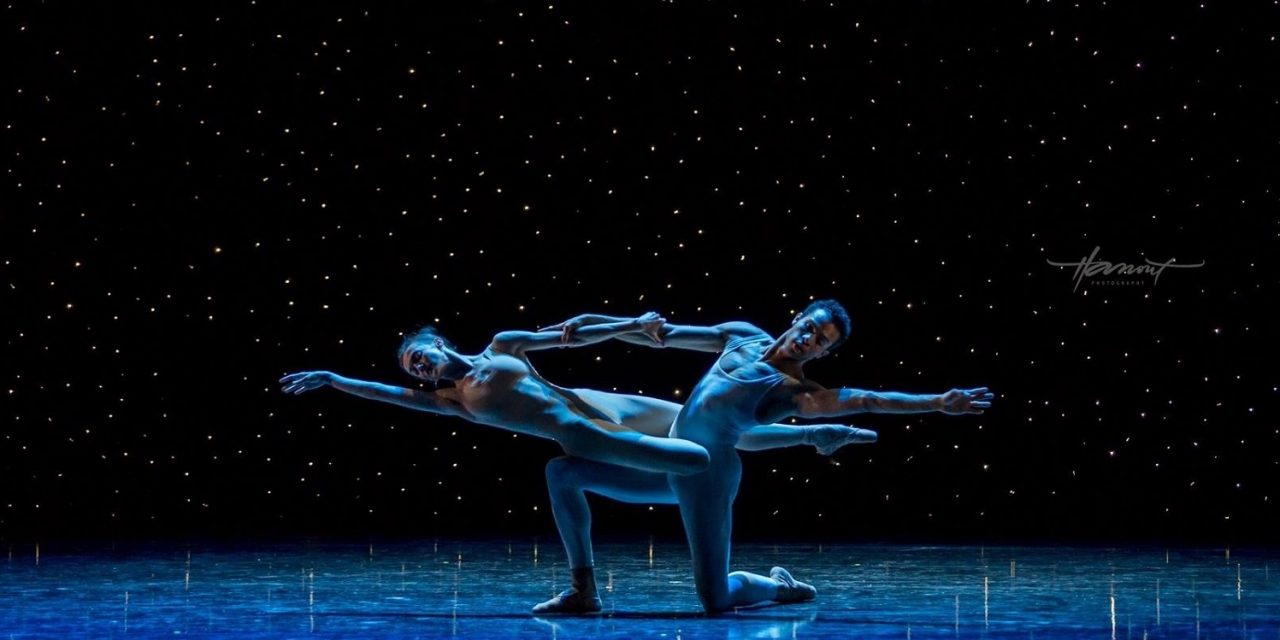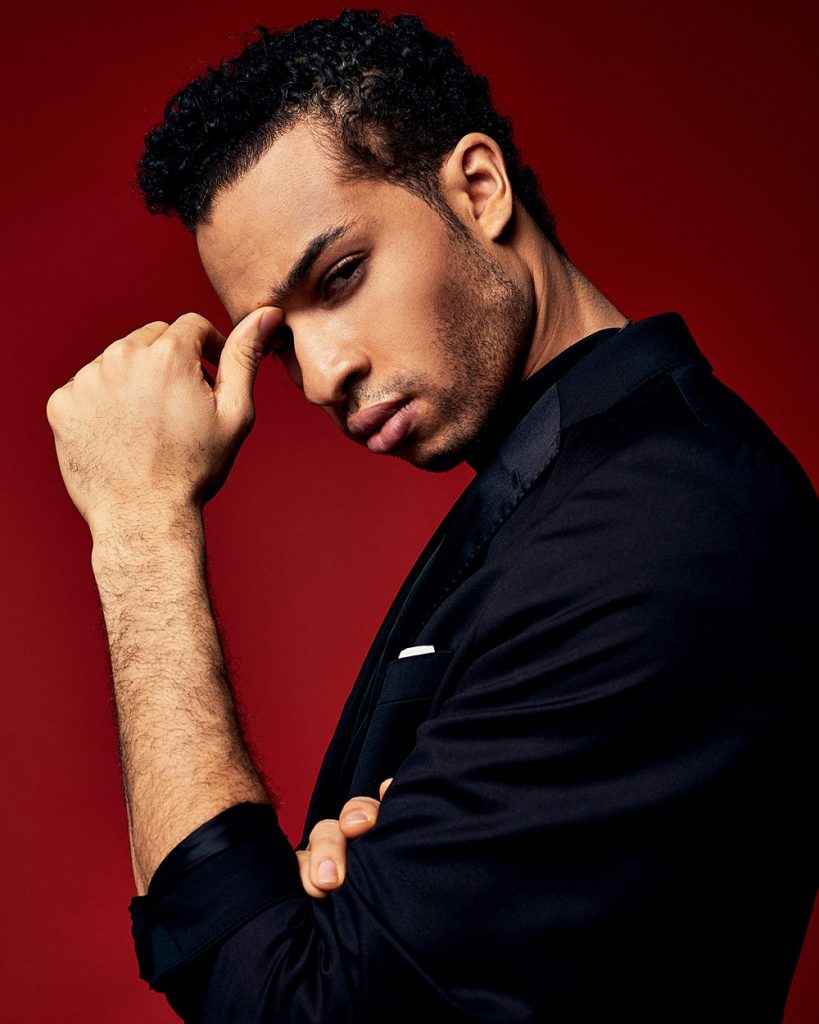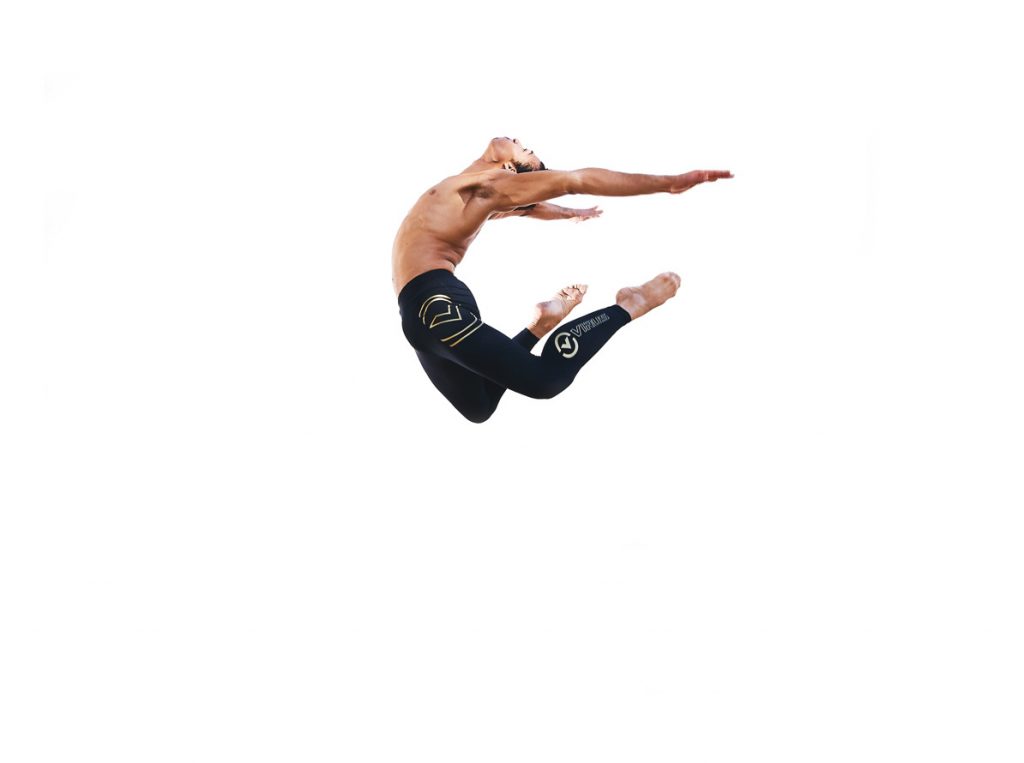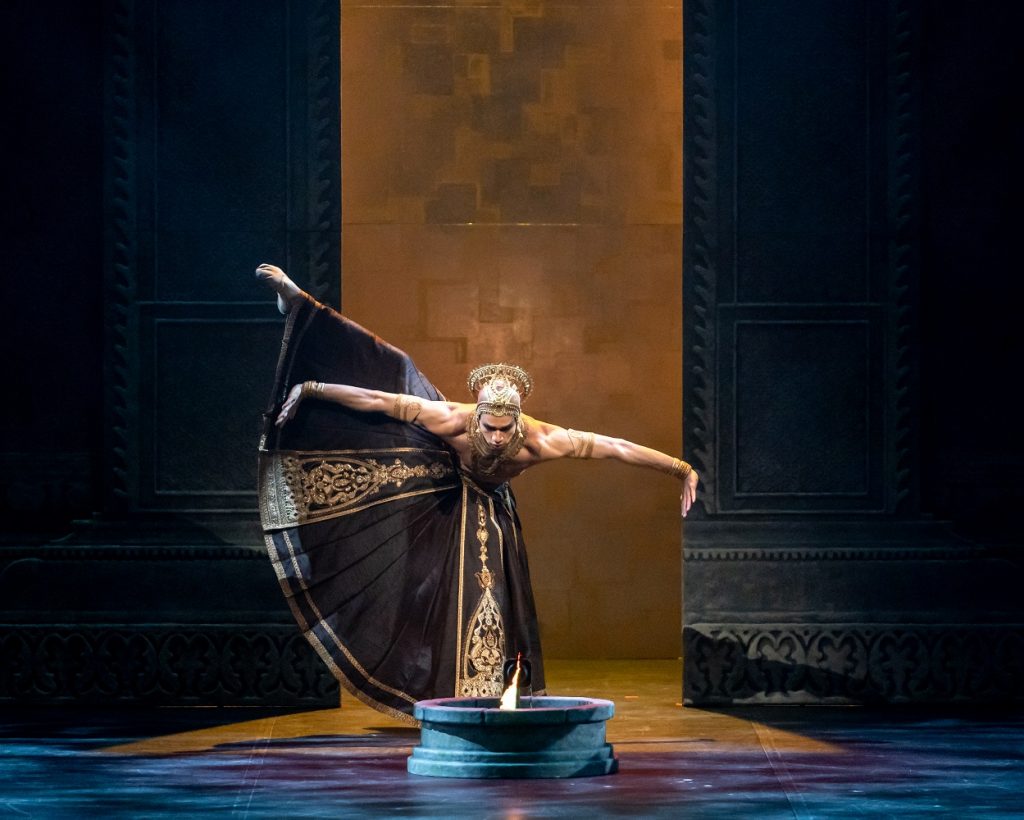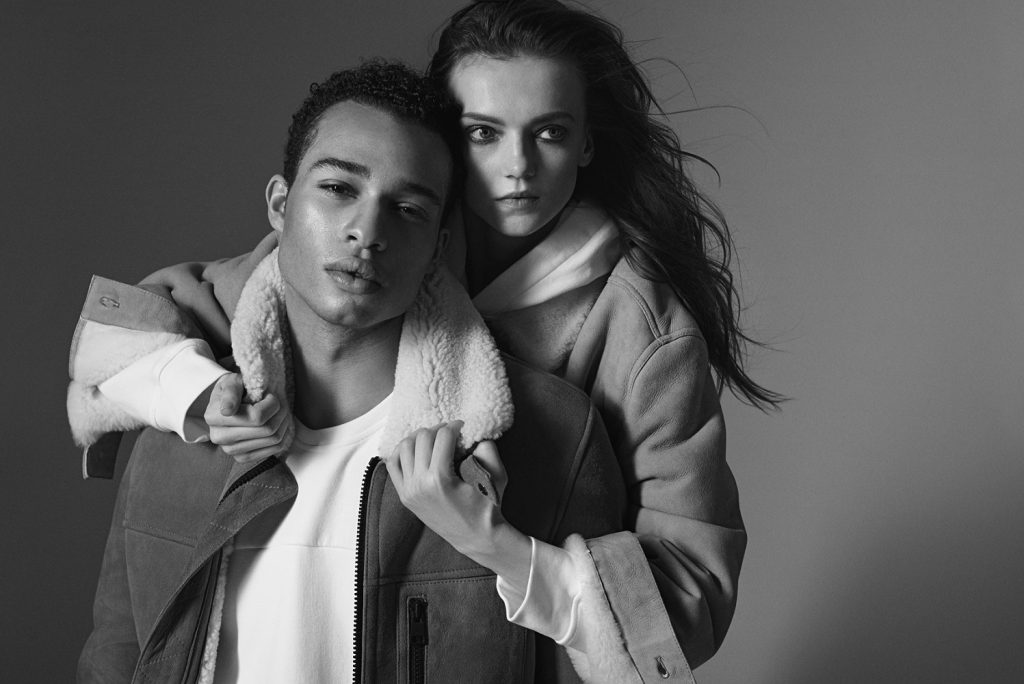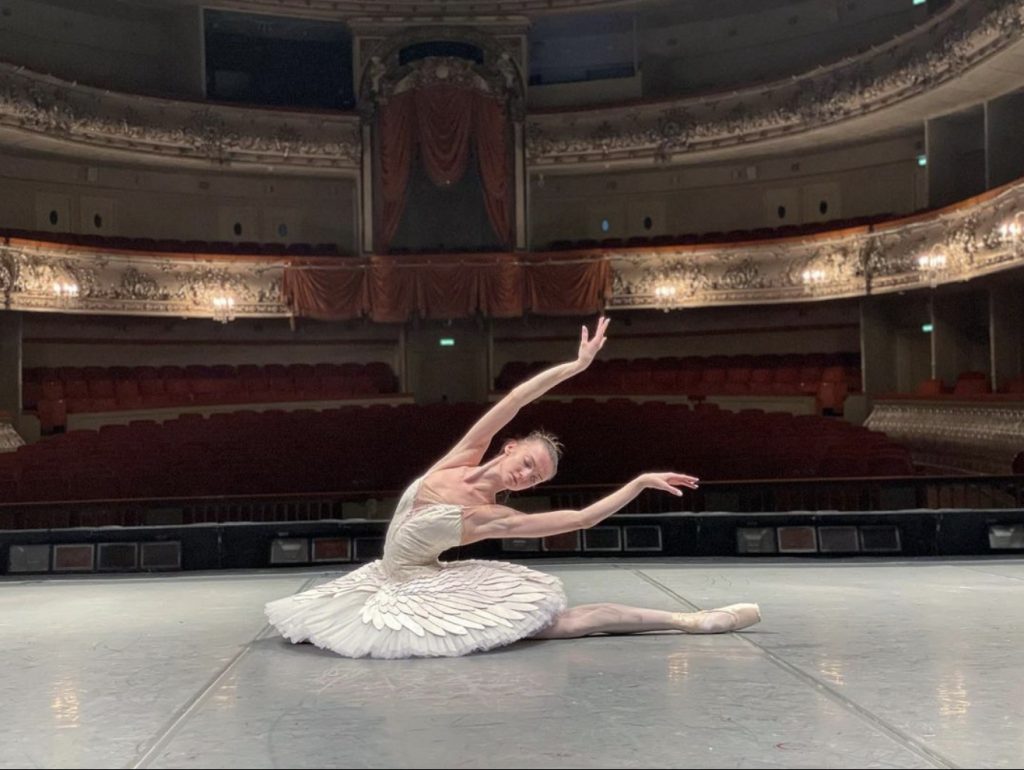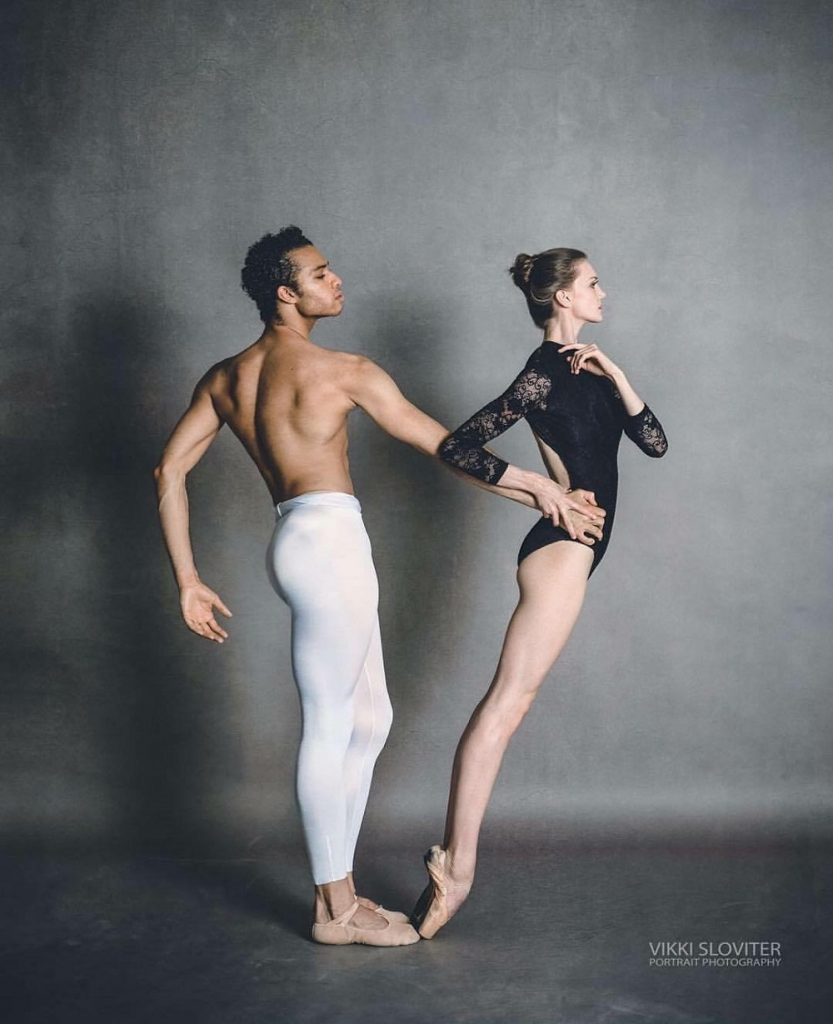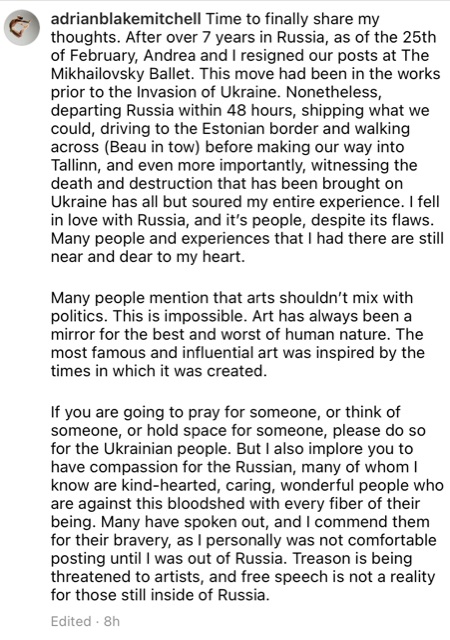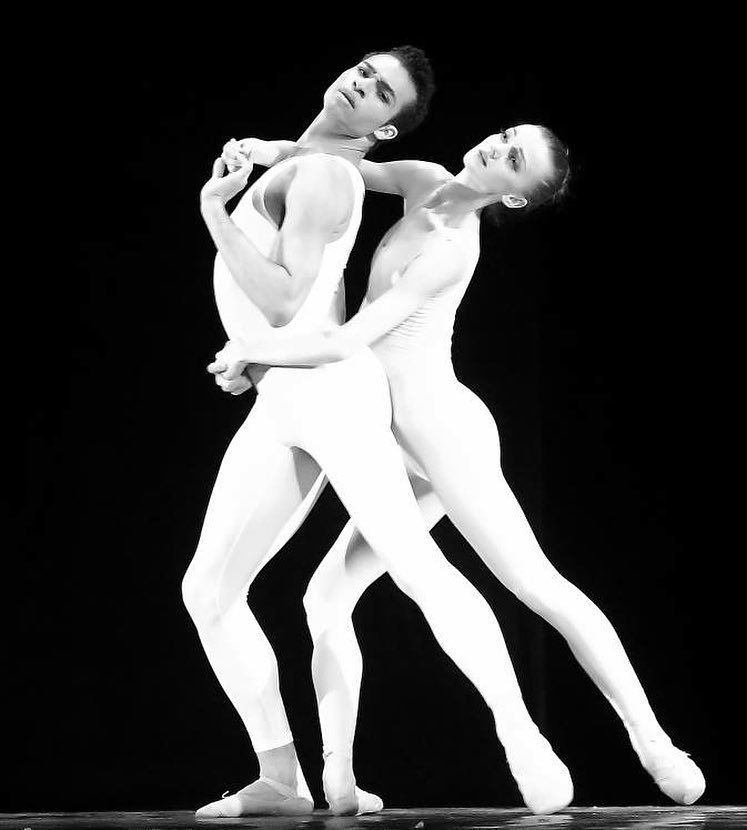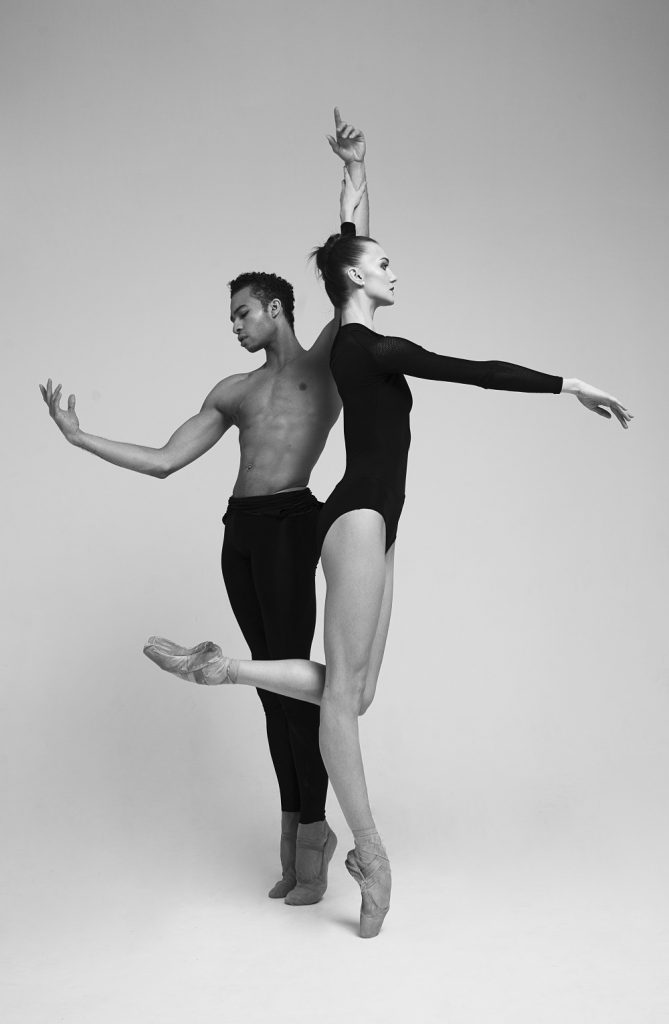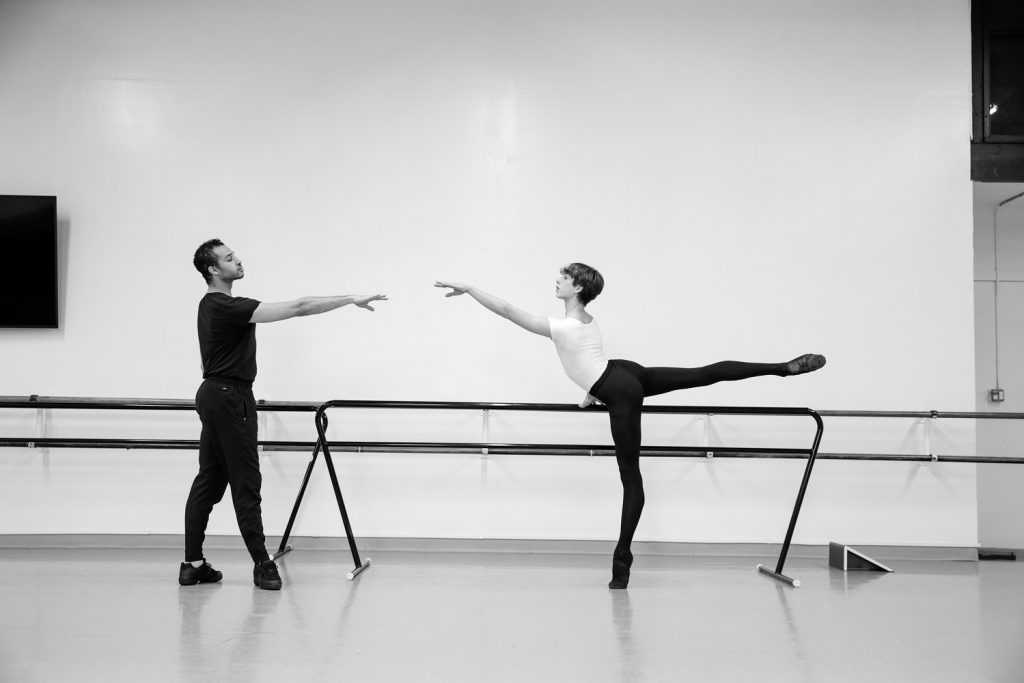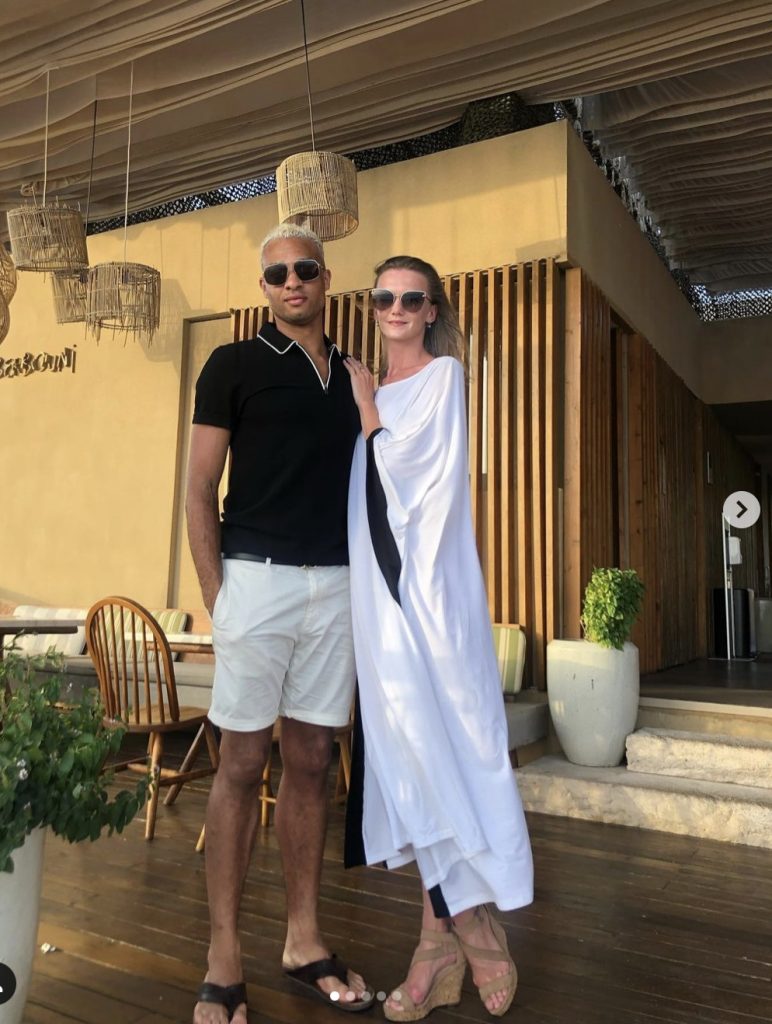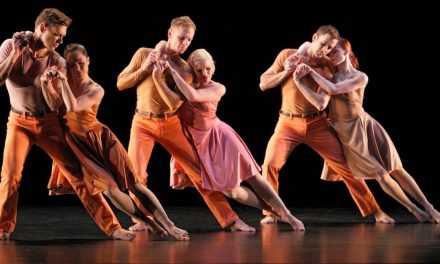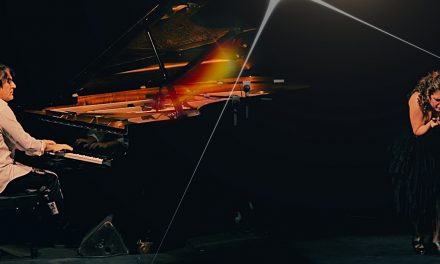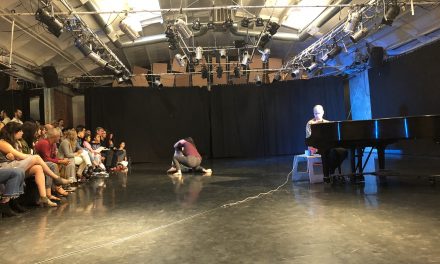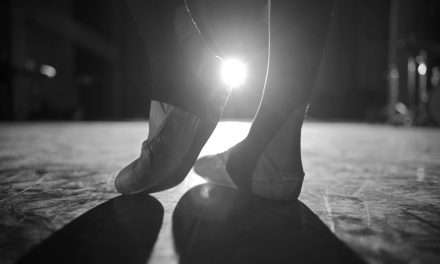Westside Ballet has been responsible for so many young and talented dancers going on to brilliant careers. Adrian Blake Mitchell followed a fascinating and circuitous route from Westside to St. Petersburg, Russia where he was schooled, danced and met his wife, ballerina Andrea Laššáková dancing with the Mikhailovsky Theatre Ballet Company. It was after their harrowing escape from Russia, at the beginning of the Ukraine/Russian War that they are making an impact on Southern California.
I had the pleasure of interviewing them prior to their Guest Appearance at the Westside Ballet Soirée on Friday, May 26 at Eli and Edythe Broad Stage in Santa Monica where they will perform Christopher Wheeldon’s After the Rain, set to live music by pianist Nathan Ben-Yehuda and violinist Misha Vayman. The following is an overview of their interesting lives and hopes for their future.
JD: Adrian, can you give me a little background on your early beginnings and how your parents encouraged such an advanced art as ballet.
Adrian: Well, my mother is one of my biggest inspirations. She raised me as a single mother and had to sacrifice so much to make sure that I could receive the best training possible to become a professional dancer.
I actually took my first ballet class at nine. I came from a very sports oriented family, so naturally my mother put me into every sport, and I wasn’t good at any of them. The last option was dance classes and I started with hip-hop and jazz and moved into ballet class because I had a crush on one of the girls there.
I continued classes off and on but took a big break in my early teens because of bullying—and we were also moving around a lot so it was difficult to get consistent training. At around 13 I fell back in love with ballet and sought out the best training possible in Southern California and that’s when I began training at Westside Ballet under the direction of Yvonne Mounsey and also with Yuri Grigoriev who was my first experience with Russian Ballet.
JD: As for your interest in classical music, how did that happen?
Adrian: My best friend since age 9, who I’ll be actually sharing the stage with for the first time, on Friday, Pianist Nathan Ben-Yehuda was actually the biggest influence on my love of classical music. My mom used to play Mozart for me as a baby, so I already had a sense and love of classical music, but I spent quite a bit of time at Nathan’s house, and he would practice piano for hours at a time playing everything from Chopin to Liszt to Debussy, so I became familiar and knowledgeable about classical music and began to build a taste for it at a very young age. One of my dream jobs if I weren’t a ballet dancer would be to be a conductor.
JD: So when did you really begin taking ballet seriously?
Adrian: Well, 14 is when I started to take it more seriously, for sure. And you know, we have a lot of different kinds of ballet schools right? You’ve got the very serious Vaganova school, where I ended up finally going and where Andrea went.
You know, Ballet. It takes more commitment, sacrifice and obsession then the average person understands. Even more than the average young dancer understands. You have to really give yourself entirely to the art form. So 13 or 14, when I joined Westside, and I started working with Yuri was when I started. Oh, okay, this is harder than I thought it was going to be. This is serious. This is not recreational. If I want to do this, I’m going to have to take it really seriously.
I’m gonna have to really apply myself.
Fortunately, Martine knew that I needed to be in a class with other boys, so she sent me the next year to Houston Ballet School, where I spent one year and I had already been doing some summer intensives. I had been to Ellison Ballet that summer. That was a huge wake up call for me! I mean it! Mr. Ellison is like a father figure to me now, but he made me cry my first time working with him, and you know, totally scared the s**t out of me.
All of a sudden it was very tiered. I was not dropped into the deep end at 10, but it still felt like a big slap in the face every time I realized how far behind I was. There were boys around the world dancing from 10 years old on such a high level. I did some intensives, and then eventually ended up going to the Vaganova school. So it was a very unorthodox path which just so happened to work out for me. I think it just fell into place at the right time.
JD: Was that in Russia? Or was that here?
Adrian : Yes, I graduated from the Vaganova school in St. Petersburg, Russia? But I had been doing a lot of Vaganova training before I went to Vaganova in Russia , which is how I got into, and why they liked me when I got there. I had been at Ellison Ballet and before that with Gelsey Kirkland. All of that was very Russian…very much of the Vaganova style. So when I got to Russia I felt like a fish-in-water, because I had been so prepared.
I didn’t speak the language. I was the first black American to graduate from the school. So for them I was so foreign in every way, except that I could dance like them. So that was really the one language we had in common. And it was amazing, because I thrived there, and I was given a lot of opportunities. I danced some of the leading roles at our graduation concert on the Mariinsky stage. I did well on my exams and things like that.
JD: Excellent. And Andrea. When did you actually start your training with Klara Scudova.
Andrea: I started when I just turned 10, and so I had to leave home because I was born in a small city in Slovakia, and the school was in the capital, Bratislava. So they used to do these auditions for the year-end program and my mom and my grandma found something in the newspaper that there was this audition. I was dancing around but it was never ballet. I didn’t even know what it was. They asked me if I wanted to audition. I said, I don’t know… like… Okay. So they took me… and I got accepted! Then I started and had to live in the dormitory when I was 10. I studied and stayed there 8 years. I was always traveling. My mom, when I was so small always went with me on Sunday. and my dad had to come on Friday to pick me up, so I was home only Saturday… one day. It was intense.
JD: it was intense, and it wasn’t even what you knew you wanted to do yet.
Andrea: No, I had no idea. Many times I cried and called my parents. They gave me the option. They said it’s okay you can go home. You know it was not like I was forced to do it.
Honestly, I had no idea what ballet was. I didn’t like it in the beginning. Sometimes they played ballet on TV, and my dad would say, Look this is what you will do… and I turn it off. I said, No! I just didn’t like it. But then I had the most amazing teacher in the beginning. Clara was just so amazing that I just naturally fell in love with it. So I think that’s what made me push forward.
JD: How did they judge if you would be able to join the school?
Andrea: I’m not sure, but I didn’t even know I was flexible. The first time I was in this audition they just put you in underwear, basically, and they check your flexibility, your feet. And that was the first time when my teacher took my leg and pulled it up here (Points above her head). I didn’t even know that I can do that…and then you have to do a little improvisation. So yeah, it was like in Vaganova. They do the same thing to get into the school.
Adrian: …and the schools was free so you can thank Socialism for that.
Andrea: It was a government school. So I only had to pay a little bit for dormitory, and like, when had to have Leotards. But point shoes, I think even the food and the studying was all for free. I told Adrian, it’s so different in America. So many kids need private lessons because they just don’t get enough education. I never ever in my life had private lessons. I didn’t even know I could. I could not even imagine at that age that you would have to work with someone else, because I had my teacher for eight years, and she had known me since I was 10.
JD: She was like a mother to you.
Andrea: Yeah, all of our teachers. I had the same teachers for 8 years, but also the good thing is that I have to put it here that my school was like a High School in Vaganova. So you actually finished and graduated with your diploma for ballet, and academics as well.
Adrian: Like an associate or bachelor’s degree?
Andrea: No, actually it’s college because I actually have a diploma that I can teach officially in small schools, not in big ballet schools, but you do have diploma. So you don’t have to be home schooled, or anything like that.
Adrian: All of it’s in one program, the academics and the ballet are all combined. So I think at least high school, you finish when you’re doing your dance training.
JD: Did you know each other in the Vaganova school?
Adrian: Well, Andrea didn’t go to Vaganova school, we met each other in the theater.
Andrea: I was already working in the company for half a year. And Adrian was finishing his year. But we didn’t know each other then.
Adrian: Because Andrea started working when she was 16 or 17.
Andrea: 17.
Adrian: So she had already been working in two companies before she came to Mikhailovsky, because she graduated and became immediately a demi soloist in Slovakia, the Slovak National Theater, and then she went to Finland. She joined first the junior company. She took a step back to go to a bigger company and then joined the corps de ballet .
Andrea: I was always cast in the main roles but I didn’t get to perform them, but I worked on them.
Adrian: Some you actually performed.
Andrea: Oh Yeah, some I did. And then I was invited to come from Slovakia to Russia by our Director.
JD: Is it still the same now with the war? Are the schools still working?
Adrian & Andrea: Oh yeah! Yes! Everything is working.
Adrian: The company still performs full time. School still works.
Andrea: The war is not happening for them. It’s like nothing changed.
Adrian: Ukraine ballet companies are like Russia; each medium size city has its own ballet company, which is usually government subsidized. So those in Russia are all working. But now because of the war, in Ukraine obviously most are not working from my understanding, but I’m not totally sure how it is right now.
JD: I don’t know if you were clever, smart, or forward thinking, but you decided to move out of Russia during the war. What made you both decide that you wanted to make that change?
Adrian: I think we wanted to live in the West after 7 years in Russia. We wanted the experience of being back in the West with some of the, what we consider, luxuries that are here. Also the artistic possibilities of working with modern and contemporary choreographers. Just different aspirations that we had in our personal and professional lives.
And then, of course, when the war started it was so obvious that it was time to go.
We did love Russia, we lived many years there and it gave us amazing careers… but let’s say, if we hadn’t been planning on leaving, we still would have eft when the war began. Almost all of our friends that are international dancers left. But some of them went back because it was hard to find work. There is not as much of an appreciation for classical art and dance in Europe and America as there is in Russia. So many of them had to go back… or felt that they needed to go back… for their jobs. So pretty much everyone left when the war started, but we were leaving permanently,
Andrea: Yes we wanted something new. It’s also because the work was really intense. We had 25 shows a month for 11 months. We didn’t have Christmas. We had a two-day holiday at New Years. And maybe, if you didn’t dance sometimes, it was very rare. You had barely a month holiday. It was very intense.
Obviously, when we came to Russia we were like in our fresh twenties. So, of course, we only wanted to dance and be on stage, but after a while, a few years, it’s hard on your body, and you know you feel like you already have an outside life from the theater. Mentally, it was hard to keep going all the time. It’s a little crazy. We just wanted something more simple. Thinking about the future, it was not sustainable, really.
JD: Yes, I always wonder about the ballerinas who have been there for so long and continued to work that hard. This brings up another point. I was searching around and found balletclass.com where many of you and your colleagues are teaching class online and finding your own businesses that way. I thought that was very resourceful. If you don’t know the language, you’re coming into a country that doesn’t appreciate what you are and what you do, it has got to be very difficult. However, this would allow you to fare well and adjust.
Adrian: Oh, yes. We try to be very open about that. Of course it was a hard way when we left Russia and the timing was terrible. It felt awful, and we still have such strange feelings about leaving all that behind, and our colleagues and friends. But yeah, we were definitely glad with that decision, and you know those kinds of opportunities are the things we wanted to be able to do and explore. And you know Balletclass.com is our friend Zander Parish’s platform. He’s a very smart guy.
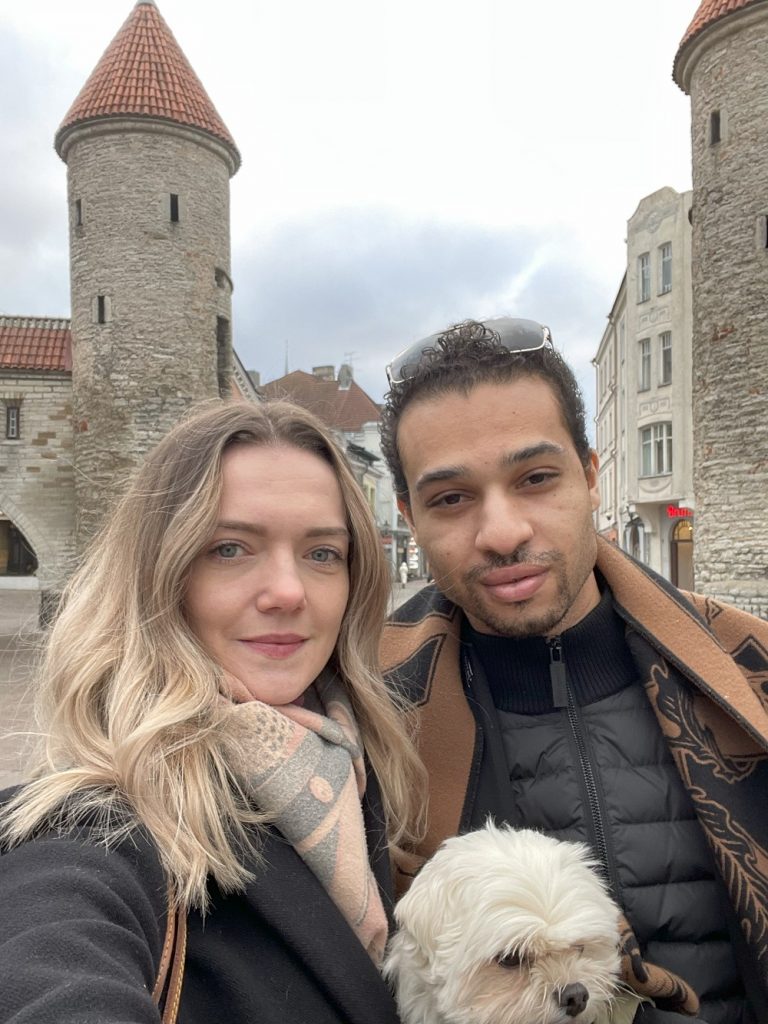
Andrea Laššáková and Adrian Blake Mitchell leaving Russia – in Tallinn Post border crossing – Courtesy of the artist
Andrea: Yes, it was only like a few months before we left Russia, you know.
Adrian: Yeah, it was. We used to go have dinner and talk about it. He would show me the designs, and I’d help him with things and give advice. So yes, very smart idea.
JD: Now when you did “After the Rain” I saw your beautiful Pas de Deux. It was gorgeous. Did you work with Christopher Wheeldon on that?
Adrian: We worked with Jason Fowler who was the second cast. He was in the original. He was in the room learning it when it was made on Wendy Whalen and Jock Soto. I picked that piece. Zander asked us, he said, “I’m doing this big gala” (Reunited in Dance). What do you guys want to dance?
I had seen Wendy Whalen dance that with… Craig Hall I believe …and I was a student at SAB’s summer intensive. I saw it in Saratoga Springs at their summer season… outside… and it had a huge artistic impact on me. I was entranced. I was a 15 year old, boy, a teenage boy, you know how they can be…and I was sitting in the audience thinking, Oh, God, I’m gonna sit here and cry in front of all my friends and the girl I had a crush on!!! It was so impactful. But I also understood in that moment the power of art and the way that you can touch the deepest part of the human soul with art, with dance as a vehicle.
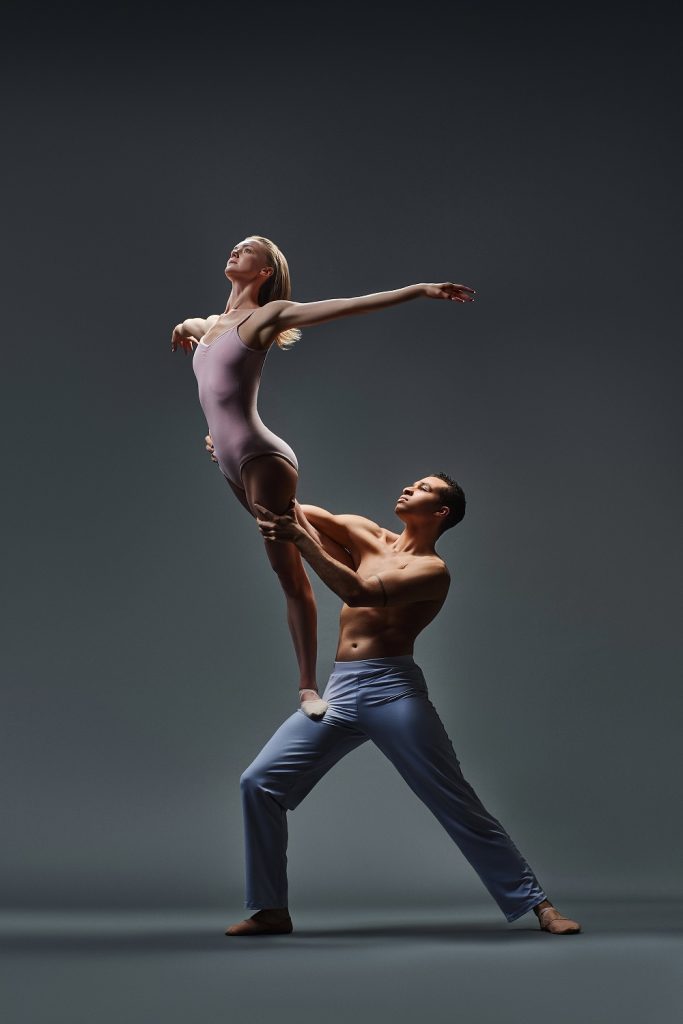
Westside Ballet – Adrian Blake Mitchell and Andrea Mitchell in “After the Rain” by Christopher Wheeldon – Photo by Eric Williams
So I said to Zander I want to do “After the Rain” with Andrea. Of course, I was so happy when she saw it and fell in love with it as much as I did. And then, again another life changing experience was when we finally got to actually dance it. I think Andrea would agree, it was an incredibly special moment and opportunity for us to do that.
JD: It was mesmerizing! Very impactful.
Adrian & Andrea: Thank you.
Adrian: We actually got to meet Chris Wheeldon a few weeks ago and he was very supportive. He has seen the video and that was the cherry on top, that we got his stamp of approval, and he had respect for the way that we portrayed it, and…
Andrea: We got the approval to dance it in the spring show. So he had to say, if we can or cannot do it. Because not everyone can dance this piece. We are very lucky, and we really appreciate that we are able to do it again.
Adrian: We were at the opening night of “Like Water For Chocolate” at the Segerstrom and we got to go to the cast party and meet everyone there. I was trying not to get totally giddy, and because he’s such an incredible artists.
JD: Because you’ve danced with such a great company in Russia, do you have any plans, to go into another company? Or do you prefer to work as guest artists. Do you have thoughts about your next step?
Andrea: I definitely like, if I can say for myself, I want to join another company, because I feel like that’s where I feel happy. You know, I have the routine, and I am very used to it. I’m working on it but it’s not easy, especially after the war in Europe. It’s really hard to get the job, because obviously, you know, they gave the positions to Ukrainian people, which is understandable. And you know, after Covid there was not a lot of money, especially in America. It’s because I was a soloist in Russia. If it were a big company of course I would go back even to the corps, and I can work my way up. But I am still working on it, because I think that’s what I want to do while I still can.
JD: And, Adrian, do you also feel the same way, or are you thinking in other directions?
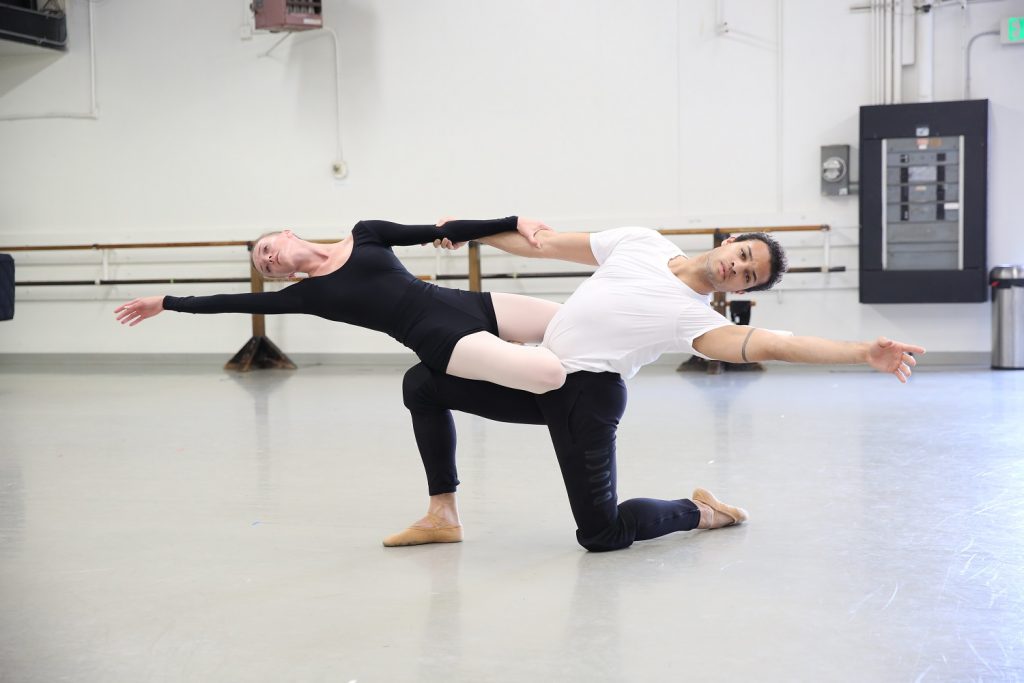
Andrea Laššáková and Adrian Blake Mitchell in rehearsal at Westside Ballet – Courtesy of the artists
Adrian: I saver every moment I have on stage, and I still know I have a lot to give as an artist and performer but I’m definitely hesitant personally to go back into the constraints of a traditional ballet company, because the programming is not based upon you by any means, so you can’t pick what you dance. You can’t schedule your own time.
So right now I’m going to be a guest artist for Los Angeles ballet, and I also teach company class. I’m getting the best of both sides of what I want to do, because I’m working on building my resume and experience to be a leader in the industry. I’m Learning the ropes from other aspects, both with Westside, and teaching class at LA Ballet. So I’m hesitant to go back into being at the will of a director for an entire season and signing my life away. I want us to perform certain things that I choose but also I’m trying to build up to shift towards a leadership position. I’m trying to walk that tightrope.
I’m doing some programming which I can’t talk about yet, but it sounds exciting, choosing my own repertoire and picking dancers and performances, and those are the things I’m interested in, and also sat on the jury of The Spotlight Awards. That was a really exciting moment. So I’m curating my time and energy really specifically.
I went through a knee injury which flares up every once in a while. But it’s so special to go on stage because we had all those performances in St. Petersburg, I was there for 6 years, and probably performed as many performances as a season dancer in an American or European company, because they have many less shows a year… by a very large amount, probably one-fifth, maybe even one tenth of what we had in St. Petersburg. So I’m just choosing my time wisely.
JD: And that sounds like you’re intelligently preparing yourself for a new step in your career… which I think is wonderful. Having been at Career Transitions for Dancers for 18 years,
I saw dancers come in and they weren’t quite finished. But it sounds like you’re actually developing the base for this change. Exciting!
Adrian: Thank you. And I still get to do After the Rain with Andrea that we will be doing in the near future, and who knows how many more after that? We’re also looking for new rep. It’s not like I’m taking off my ballet shoes, but definitely, like you said, just building a foundation for something different.
JD: Maybe bigger? Who knows?
Adrian: Who knows? It could be?
JD: So you started a nonprofit with another person, and co-founded Dance in Color. Could you tell me a little bit about that?
Adrian:
Adrian: Yes, a little idea about that. I co-founded it with a childhood friend who I did my first ballet classes in Malibu, Chelsea. We started Dance in Color over the quarantine when we had all of that incredible social justice movement.
We started Black Ballet Talks where me and my friend Jason Ambrose, the Principle of the Children’s division at San Francisco Ballet School were long time friends, and we were just doing this thing called Black Ballet Talks. We were talking about racial injustices in the ballet world, and mistreatments and micro aggressions, and all the nasty things that we’re trying to get rid of right now in our industry, and my friend Chelsea wrote me and said, oh, you know I want to do something. Let’s make something, and she wanted to make a scholarship. I said, Yes, let’s do that. But let’s build something around it, and we just brainstormed this big organization which we’re now building called Dance in Color. The main thing it does right now is provide scholarships for underserved by BIPAC youth to study dance on a professional level.
So that’s what our main focus is. But we also worked with Westside to start Dance to Dreams, which is a summer program, bringing underserved communities or underrepresented communities into the ballet studio, and giving them a chance to learn the first steps of ballet in a space that is inclusive and welcomes them, and they’re not feeling “othered.” They’re feeling welcomed and at home.
We’ve been doing that together with Westside. I’m. Kind of on both ends. Dance in Color is a non-profit and it’s all about fundraising. So right now we’re in a really intense fundraising period, working to be able to build the base to do this, because, you know, we’ve run into these incredible little artists all around the world who can change the way the ballet looks, you know, but it has to be done at a young age, and socioeconomics are always part of the equation in ballet in general. So a friend of mine, Silas Farley who runs the Colburn School, put it really well. He said we have to widen the net. So just widening the net. So we’re recruiting little Ballerinas, because usually we find them in Connecticut or Orange County, or you know, some of these affluent communities that are mostly white. But we’ve got the same talent in Compton and the Inner Cities and south side of Chicago, but they have no opportunity to study ballet. They wouldn’t in 1 million years find themselves in a ballet class, and when they do, it’s very rare. So that’s the goal.
I have to mention that Chelsea and I had the first ideas. We quickly brought in one of Chelsea’s close friends. Casey Morris, who is now our Director of Development and Licensing. She also is an integral part, as is Andrea and Dominique, Chelsea’s husband. All three of them are an integral part of the organization. So
JD: That’s so great. Now at Westside you obviously do the boys classes. But you’re doing other things aren’t you?
Adrian: Yeah. I’m wearing a lot of hats. I’m learning a lot, and I’m helping a lot, and I’m making really amazing progress. I’m the Associate Executive Director because one of my aspirations would be to find myself also on the other side of our industry, which is the Arts Administrative, Executive Leadership side of the coin. So I’m here as the Associate Executive Director and I get to do a lot of interesting things. I help hold down the Fort for our Owner and Executive Director, Allegra Clegg, Yvonne’s daughter, the Founder’s daughter. And then we’ve done some new things. I mean, you know there was not an Associate Executive Director before I came, so it’s not that carved out yet, but we’ve done things like we’ve brought in two incredible leaders for our Leadership and Dance Master Classes, which was Sascha Radetsky and Jason Ambrose. We brought them in for master classes. We’ve been building our community outreach and diversity efforts. We have been reaching out to alumni. We’ve started a trainee program with Los Angeles Ballet, which is the first time we’ll have a full day program which is very exciting.
JD: Tell me about that!
Adrian: Yes, it is so Westside has a non-audition after school program, which is a wonderful resource for the community. We wanted to be able to provide a service to some of our really competitive students who are going off to these big ballet schools. Something that can emulate that you might get is going away to some of these larger ballet schools. So we built the training program with Los Angeles ballet in collaboration with us.
It’s a full day program. They start in the morning. They’ve got ballet classes, partnering, mime and acting, character contemporary stretching, strengthening conditioning, separate men’s classes, of course, variations …all of that for a substantial amount of hours a day.
It’s an exciting program. Some of these schools have day programs, but I don’t think I’ve seen anything as comprehensive as this will be.
Everyone says, oh, do you want to go back to the East Coast, because it’s all happening over there? And I said, Well, why can’t it happen over here? I think we can do it. You know, Melissa (Barak) is doing wonderful things with Los Angeles Ballet, and a lot of these schools are making great strides. So I think we can do it.
Also for the first year we competed at YGP (Youth Grand Prix), we got 3 gold medals. Our first in the first regional. Three boys and 3 different age Divisions got first place in the regional competition in Los Angeles which is one of the most competitive cities for the competition.
Andrea: So you know it’s well, best of 24. There were thousands of kids at the competition.
JD: Yes, YGP is so competitive…
Adrian: Yeah, I mean, I work closely with Martine, who’s in a very wonderful leader, Artistic Director. So I help supplement whatever she needs to constantly, we say, to raise the bar, spelled “Barre” for the school… raising the level. We kind of live on this fine line, which we’re happy with, of being a community…an open place for anyone to come to classes. We never turn anyone away. We don’t do auditions but provide some of the best training in Southern California.
And the company will be able to perform with the Los Angeles ballet, or with the Westside performances, you know, so they will get opportunities to be on stage, which is great because…I told Adrian that I started working when I was 17. My mom had to sign my contract because it was not legal yet. You know I was like fresh 18 when I was about to start, so I think it’s good for them because they need this experience. You know they can’t just be in a studio working. They need to get out there and perform.
JD: We need this here! I am happy it will be done. It’s very important. Andrea, you’re going to be part of this group. Since you are together now, how will you manage the fork in the road if you find a company Andrea?
Andrea: I mean, for now I’m here. I also sub sometimes at Westside when they need me and work privately with the kids. Of course, obviously, it’s hard to find balance, but I think we understand each other well enough that we want success for each other. He has a lot of opportunities here, and I would never take that away from him because he’s done a lot for me in Russia. He’s helped me with so many things. So I think we will just manage. I don’t need to dance for 10 more years, you know. I just need a few more good years.
Adrian: And we’ll get some good airline miles out of it.
JD: Oh, yes, and will you go back to Russia?
Andrea: It’s still out there, you know, like we don’t know what will happen. We didn’t settle down 100 percent here, but for now we are here, and Adrian is doing amazing work. I’m so proud of him. And what will happen in the future? We will manage. We will be fine.
JD: It’s so wonderful because you’re kind to each other.
Andrea: Adrian also knows that being on stage makes me happy, and it’s something that I should be doing, and he know how important it is for me. So he’s not telling me ever that, we are here now, I got a job and you just have to change your career. You know there’s never any question. We both have our freedom, and we do the best for each other.
JD: So he’s not asking you …” Where my dinner?”
Adrian: No! (laugh) I’m the one who cooks mostly in the family? I love to cook. Although when I need comfort food, Andrea makes a mean Slovak traditional dish.
Andrea: I know how to cook. I’m just not as refined as he is, you know. I’m his sous chef when he cooks. (All laugh).
JD: That’s wonderful!. Your Westside experience …your connections, performing and leadership is actually flowering for you. It’s vital what you’re doing. I am very excited to hear about your continued successes. There’s much to do and plan for. I wish you both good fortune in your endeavors and look forward to seeing your performance on Friday May 6 at BroadStage.
For more information about Westside Ballet, please visit their website.
Written by Joanne DiVito for LA Dance Chronicle.
Featured image: Andrea Laššáková and Adrian Blake Mitchell in Barbers Adagio – Slovakia performance – courtesy of the artists

